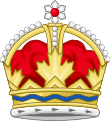| Charter of Rights and Freedoms | |
|---|---|
 English language version of the Charter | |
| Created | 1982 |
| Purpose | To protect the rights and freedoms of all Canadians |
| Full text | |
 |
|---|
| Part of a series on the |
| Constitution of Canada |
|---|
 |
|
|
The Canadian Charter of Rights and Freedoms (French: Charte canadienne des droits et libertés), often simply referred to as the Charter in Canada, is a bill of rights entrenched in the Constitution of Canada, forming the first part of the Constitution Act, 1982. The Charter guarantees certain political rights to Canadian citizens and civil rights of everyone in Canada from the policies and actions of all governments in Canada. It is designed to unify Canadians around a set of principles that embody those rights. The text of the document is set in the Cartier typeface, designed by Carl Dair to celebrate the centenary of Confederation.[1] The Charter was proclaimed in force by Queen Elizabeth II of Canada on April 17, 1982, as part of the Constitution Act, 1982.
The Charter was preceded by the Canadian Bill of Rights, enacted in 1960, which was a federal statute rather than a constitutional document. The Bill of Rights exemplified an international trend towards formalizing human rights protections following the United Nations' Universal Declaration of Human Rights,[2] instigated by the movement for human rights and freedoms that emerged after World War II.[3] As a federal statute, the Bill of Rights could be amended through the ordinary legislative process and had no application to provincial laws.[2] The Supreme Court of Canada also narrowly interpreted the Bill of Rights, showing reluctance to declare laws inoperative.[a] Between 1960 and 1982, only five of the thirty-five cases concerning the Bill of Rights that were heard by the Supreme Court of Canada resulted in a successful outcome for claimants.[2] The relative ineffectiveness of the Canadian Bill of Rights motivated many[who?] to improve rights protections in Canada. The British Parliament formally enacted the Charter as a part of the Canada Act 1982 at the request of the Parliament of Canada in 1982, the result of the efforts of the government of Prime Minister Pierre Trudeau to create a "Just society".
The Charter greatly expanded the scope of judicial review, because the Charter is more explicit with respect to the guarantee of rights and the role of judges in enforcing them than was the Canadian Bill of Rights. Canadian courts, when confronted with violations of Charter rights, have struck down unconstitutional federal and provincial statutes and regulations or parts of statutes and regulations, as they did when Canadian case law was primarily concerned with resolving issues of federalism. The Charter, however, granted new powers to the courts to enforce remedies that are more creative and to exclude more evidence in trials. These powers are greater than what was typical under the common law and under a system of government that, influenced by Canada's parent country the United Kingdom, was based upon Parliamentary supremacy. As a result, the Charter has attracted both broad support from a majority of the electorate and criticisms by opponents of increased judicial power. The Charter applies only to government laws and actions (including the laws and actions of federal, provincial, and municipal governments and public school boards), and sometimes to the common law, not to private activity.
- ^ Writer, Katie Daubs Feature (September 27, 2015). "The man who gave Canada its own typeface finally gets his due". Toronto Star. Retrieved October 29, 2024.
- ^ a b c Monahan, Patrick J.; Shaw, Byron; Ryan, Padraic (2017). Constitutional Law (5th ed.). Toronto, ON: Irwin Law Inc. pp. 409–410. ISBN 978-1552214404.
- ^ Hogg, Peter W. (2003). Constitutional Law of Canada (student ed.). Scarborough, ON: Thomson Canada. p. 689.
Cite error: There are <ref group=lower-alpha> tags or {{efn}} templates on this page, but the references will not show without a {{reflist|group=lower-alpha}} template or {{notelist}} template (see the help page).